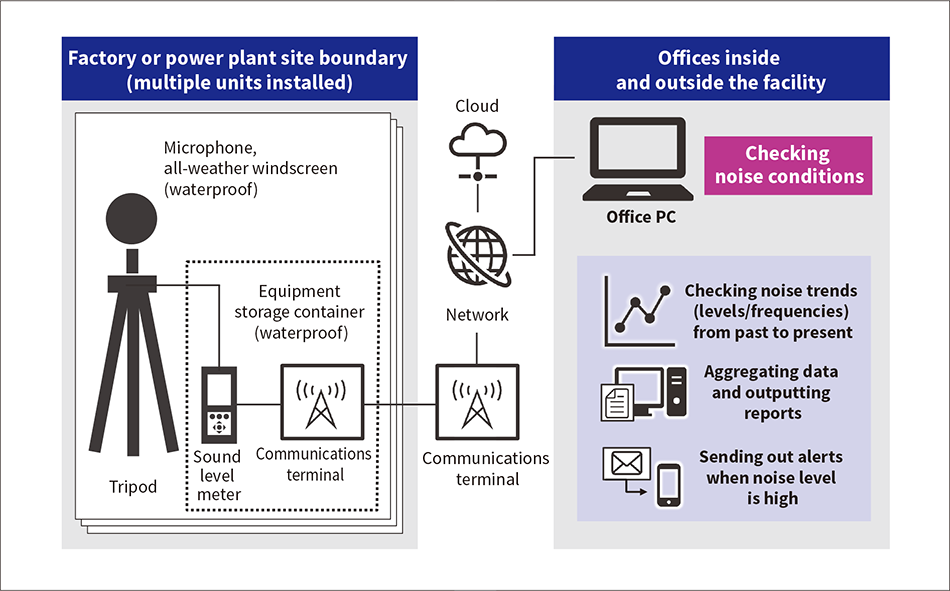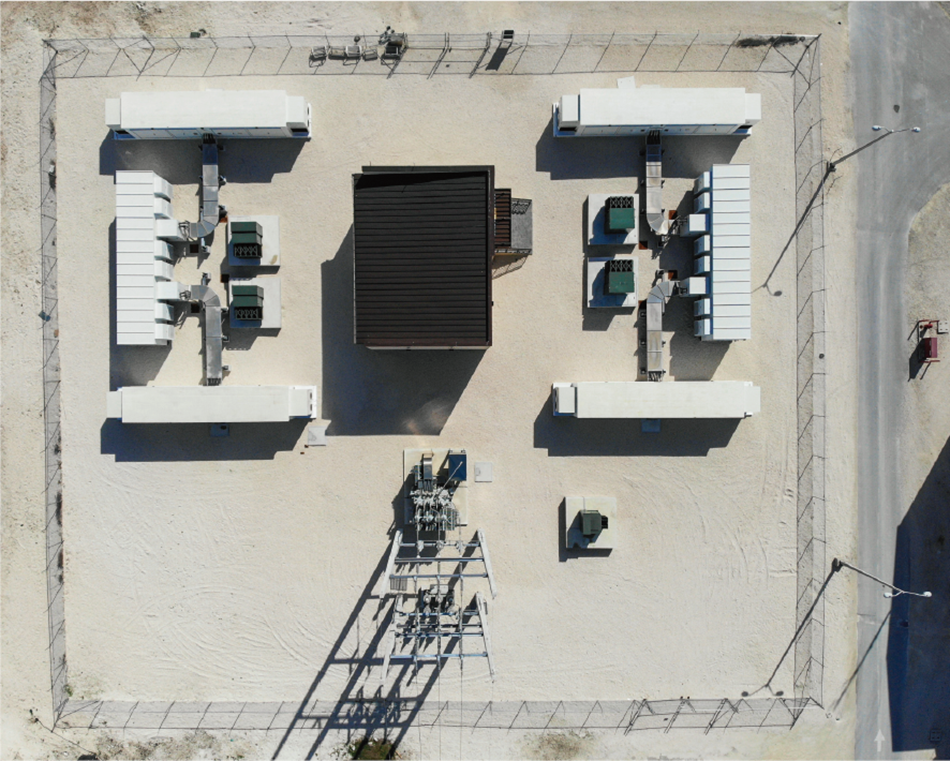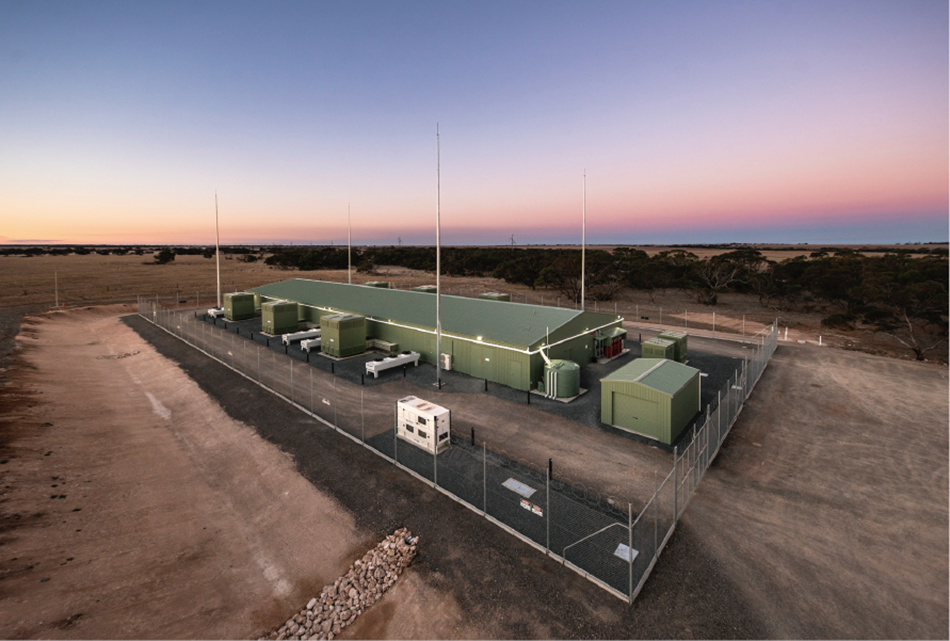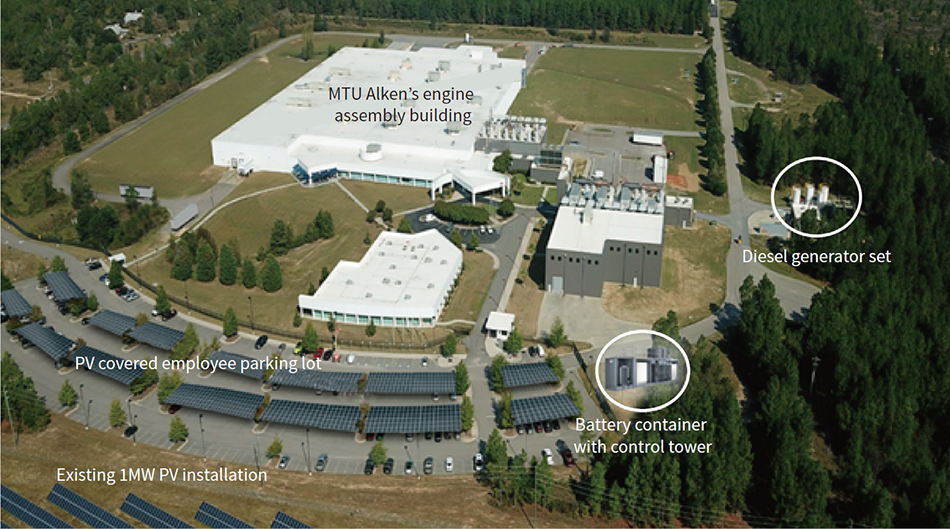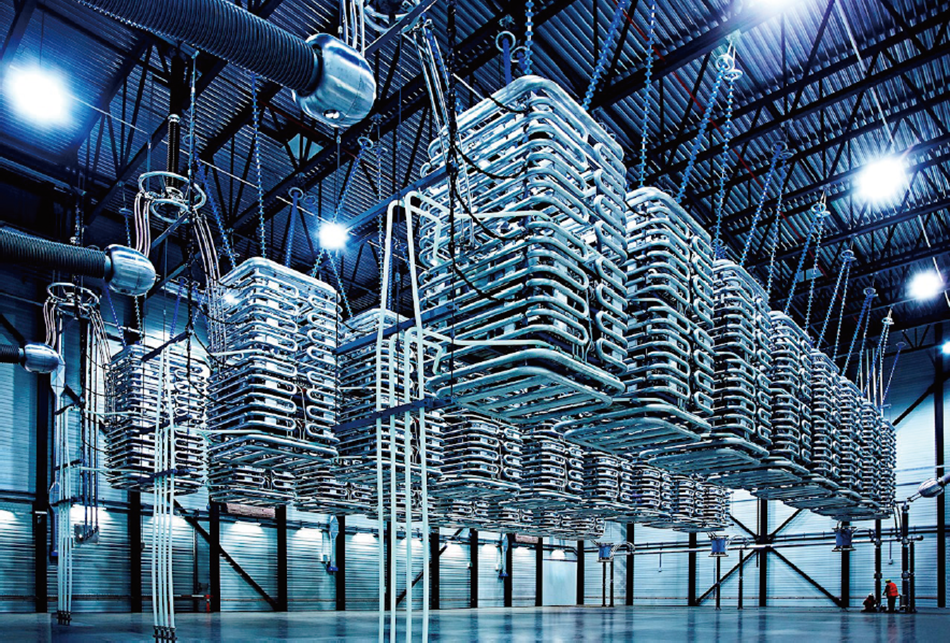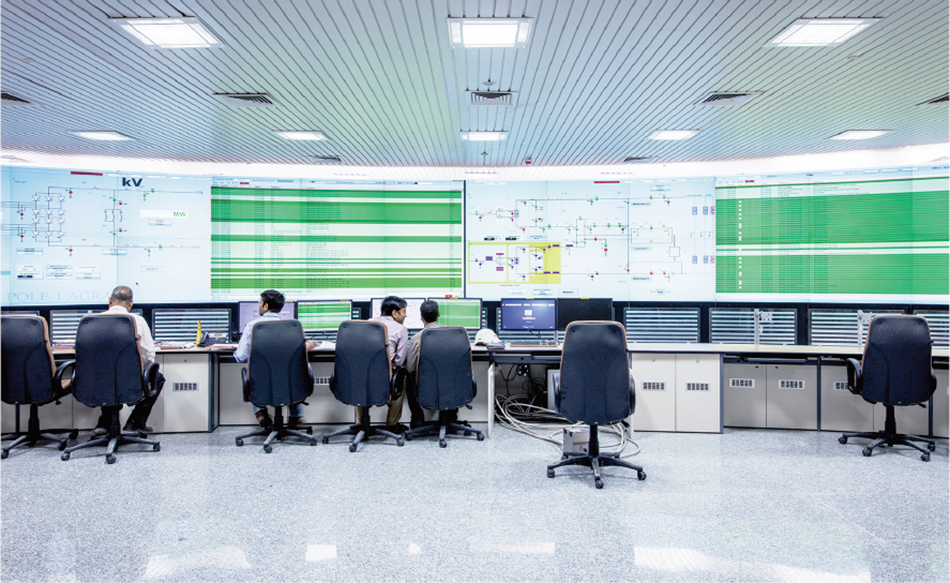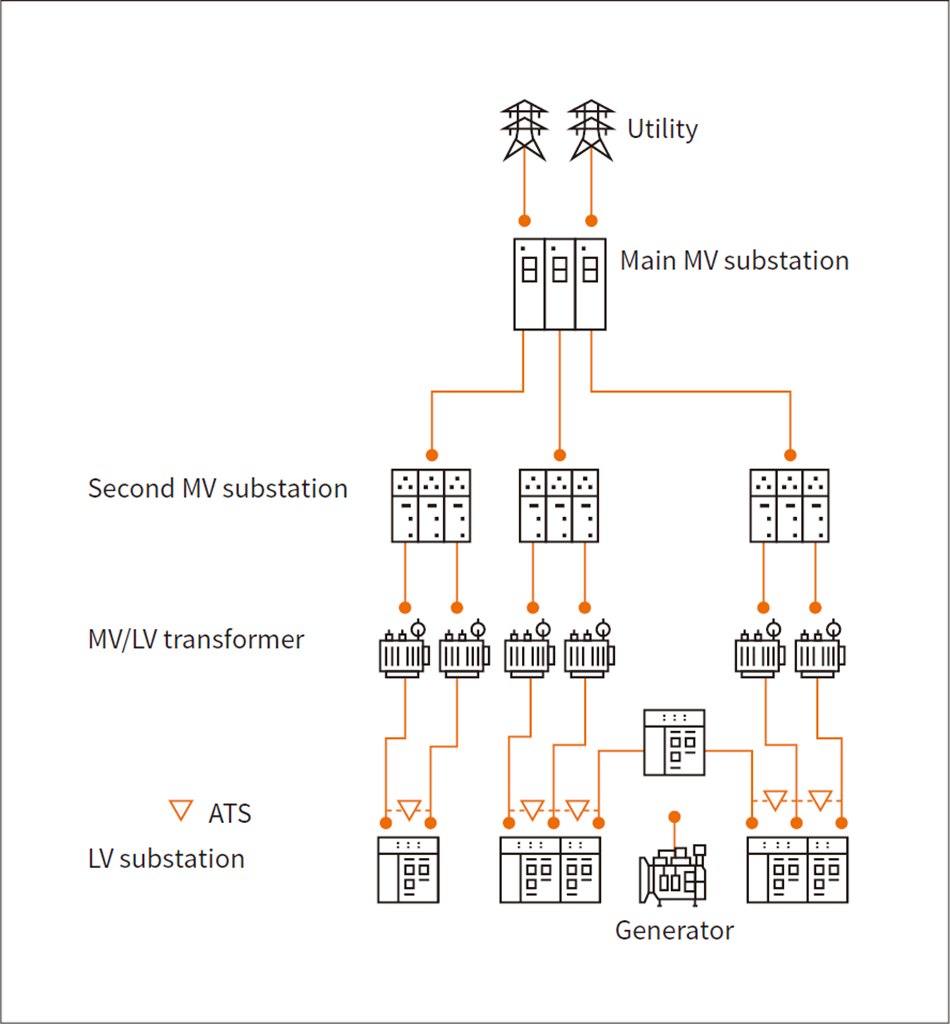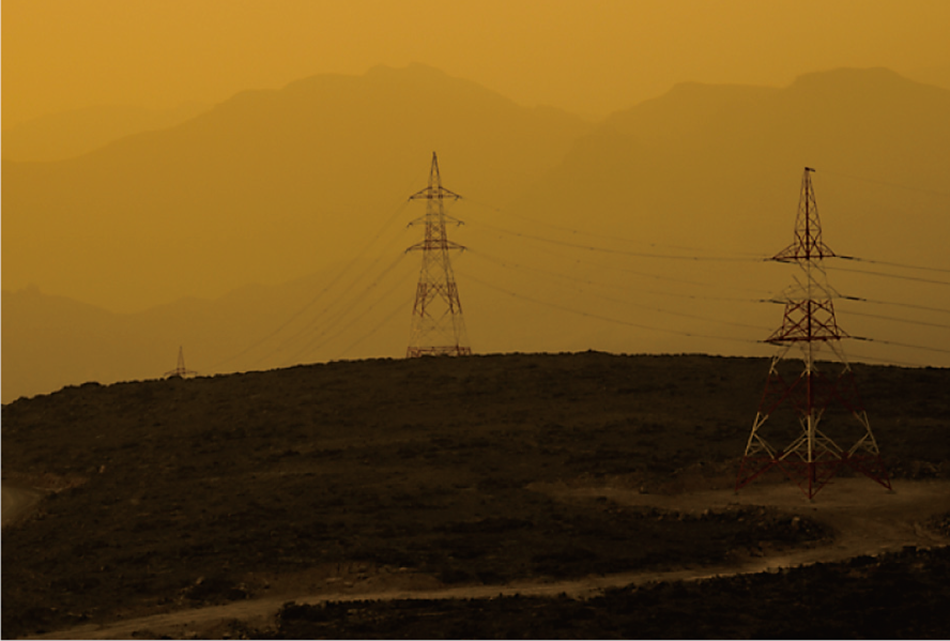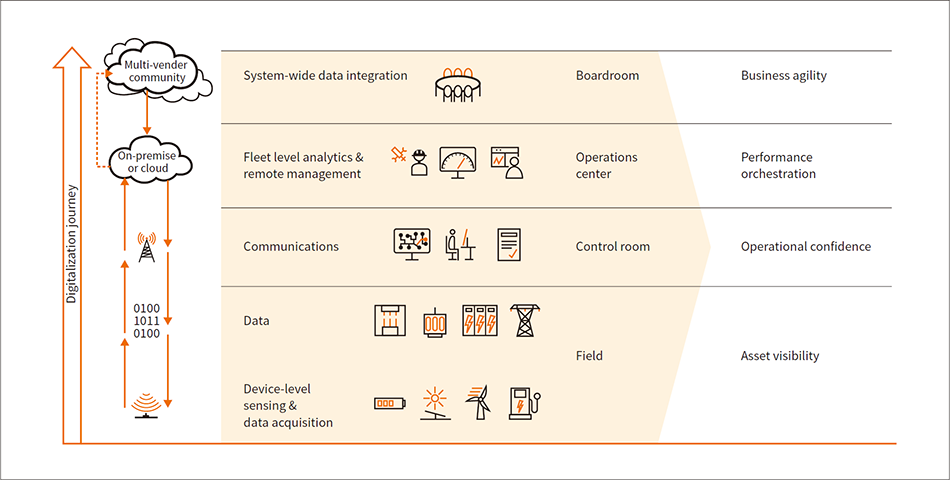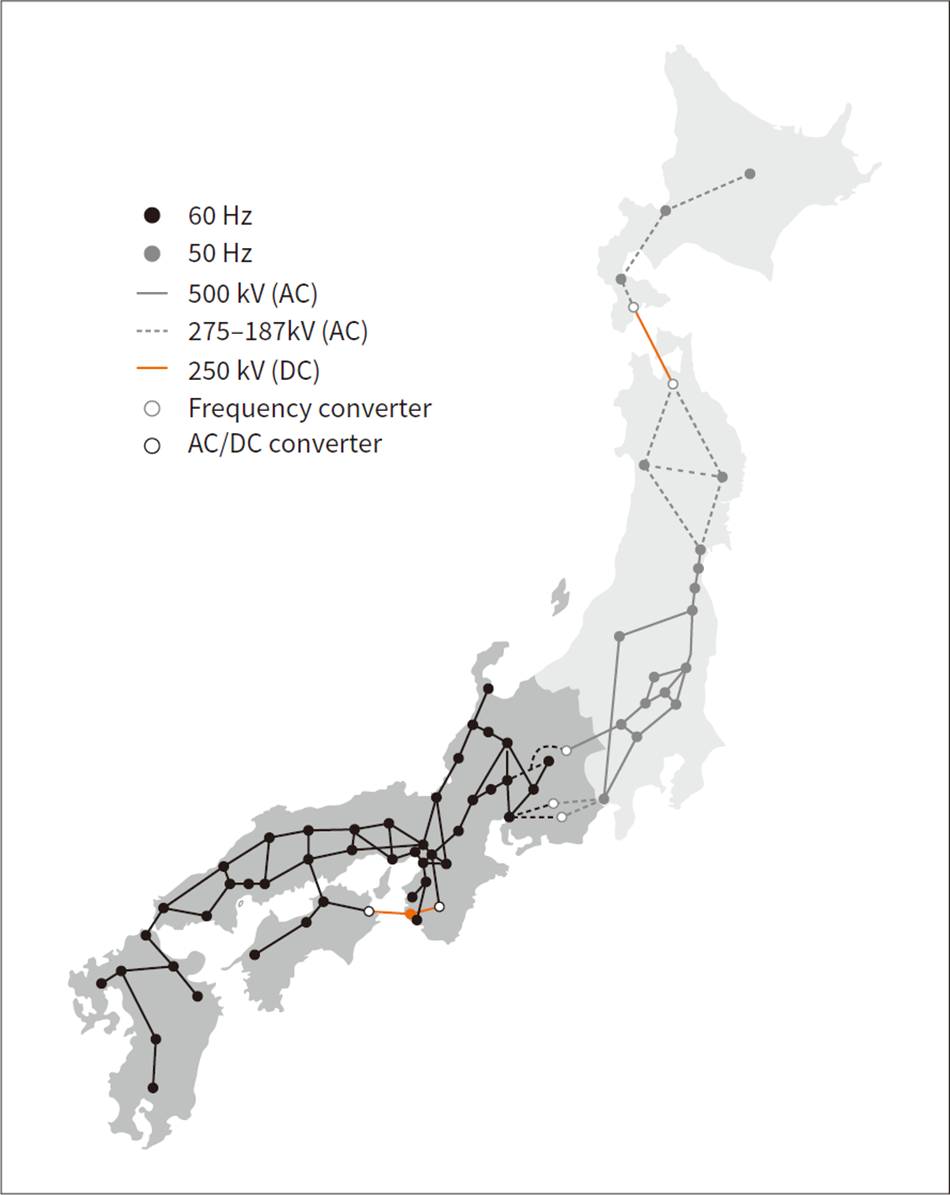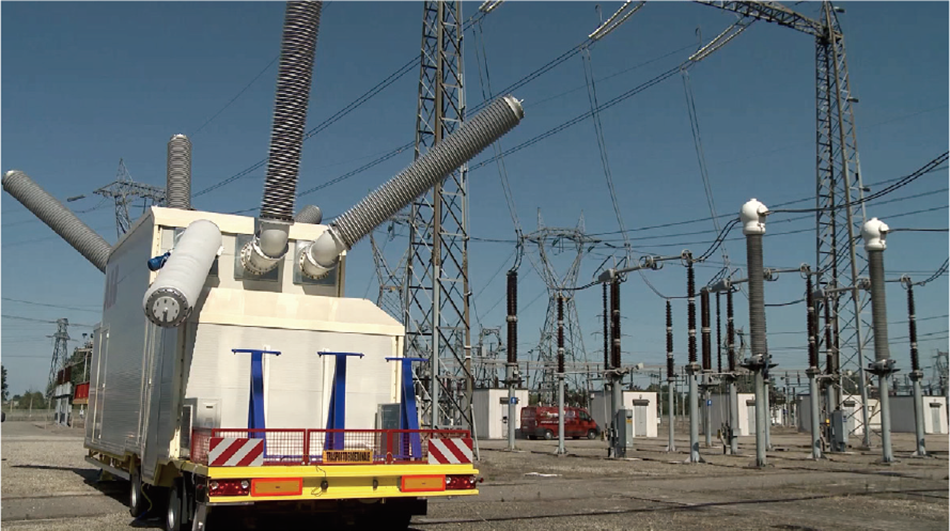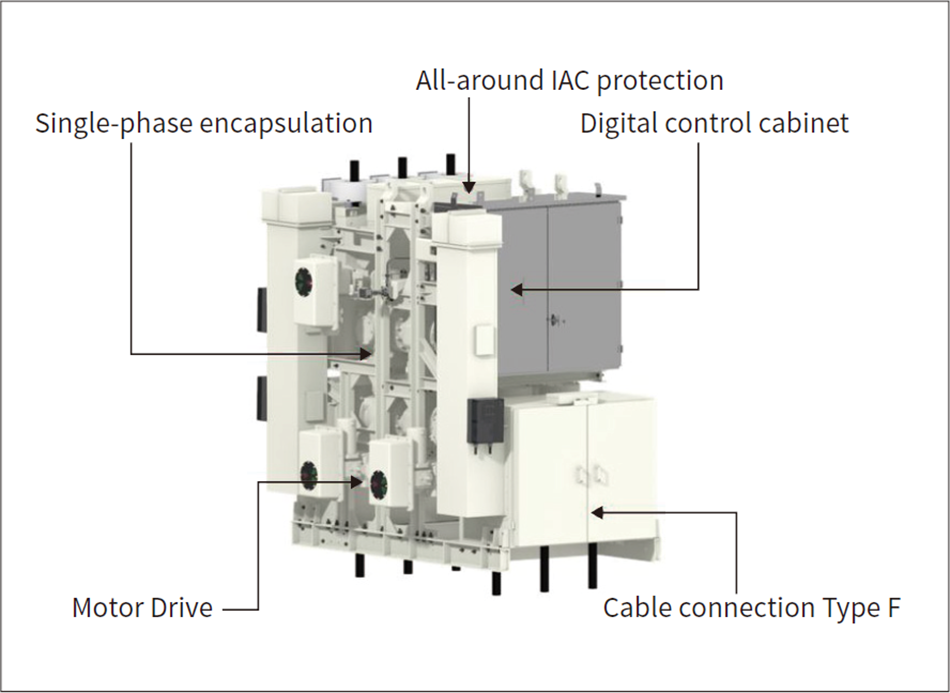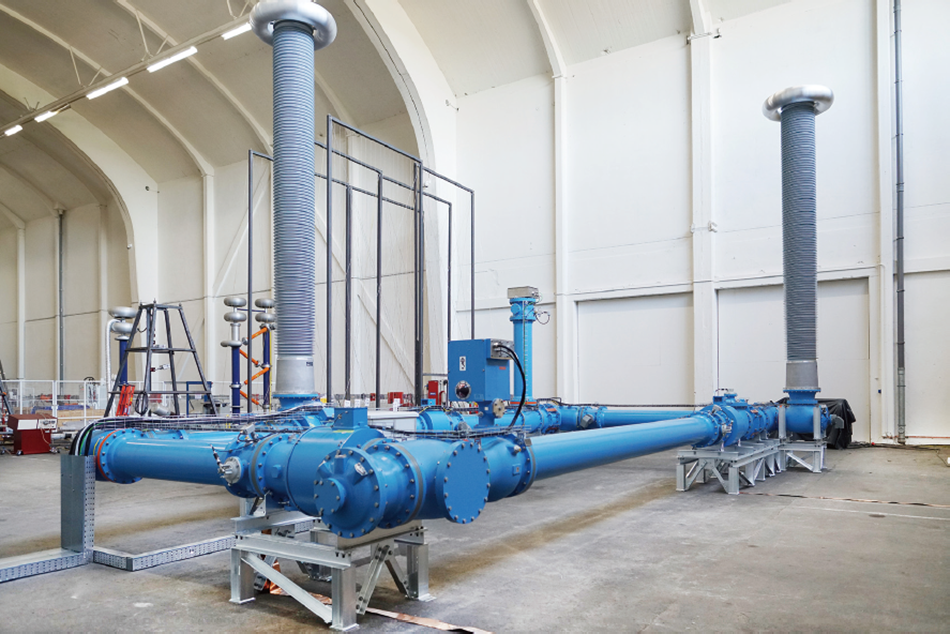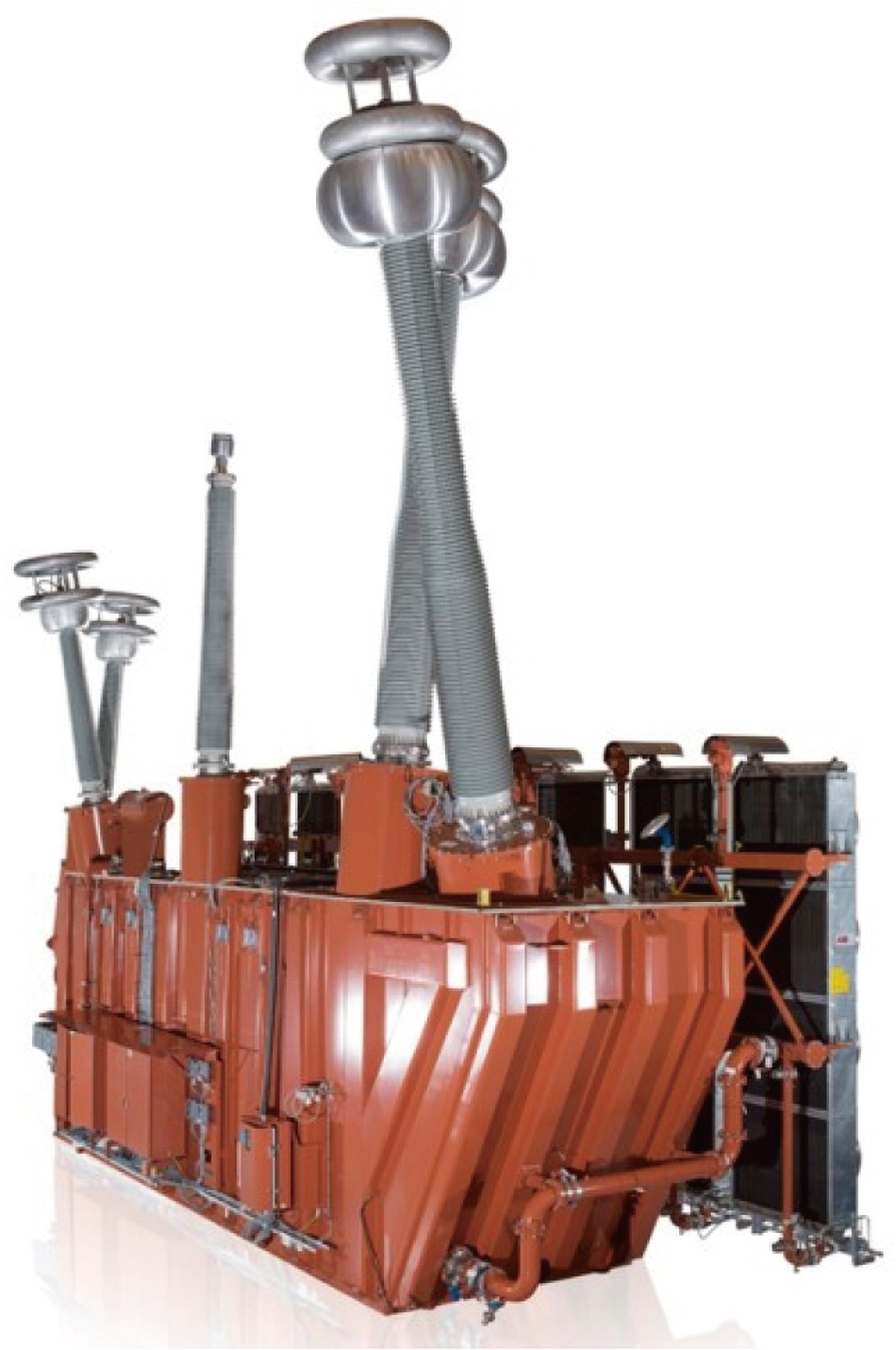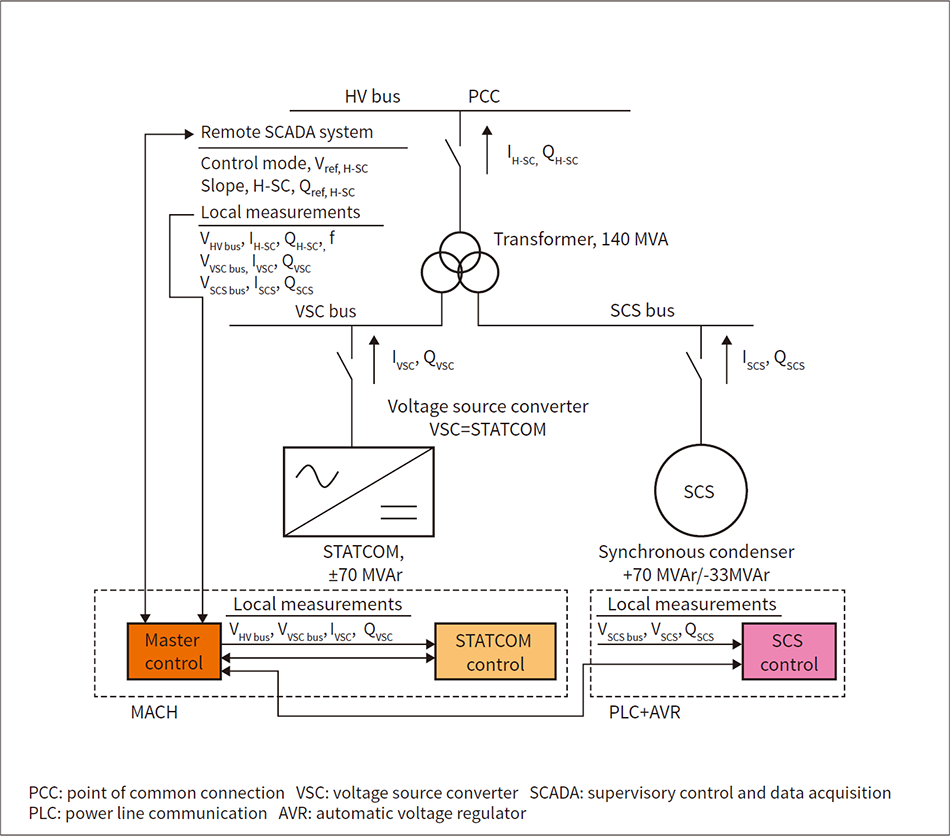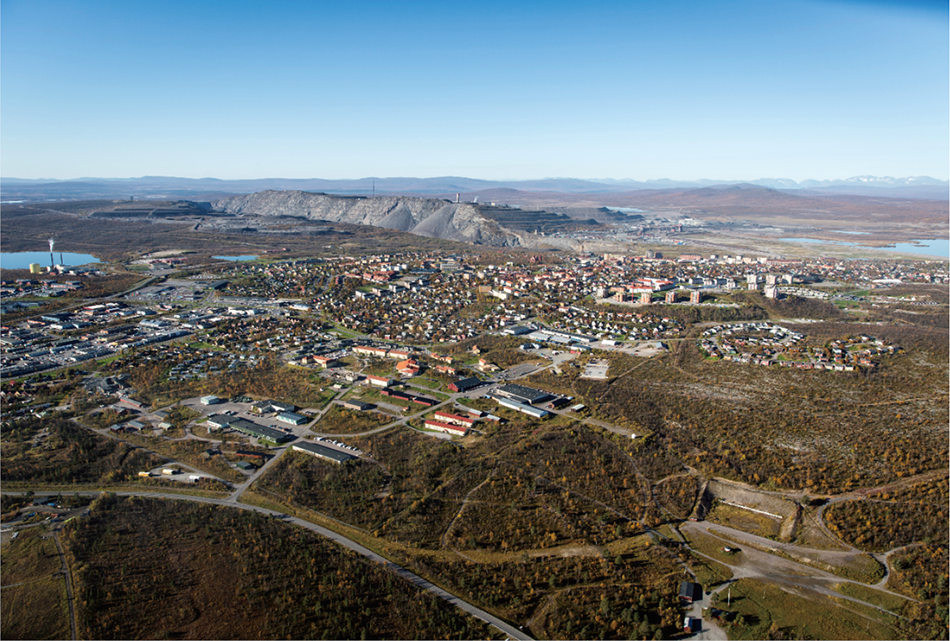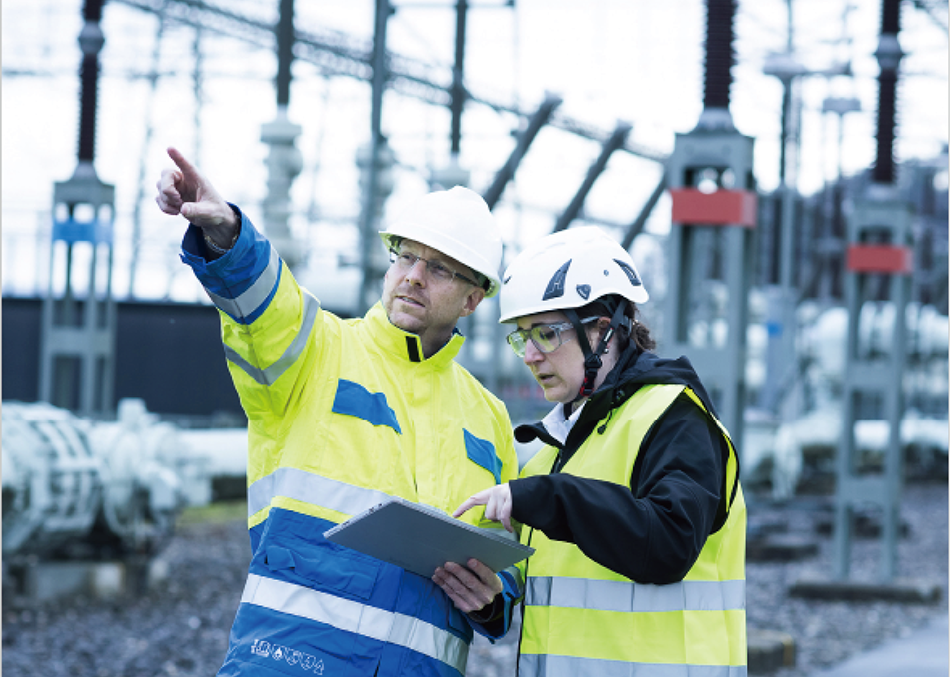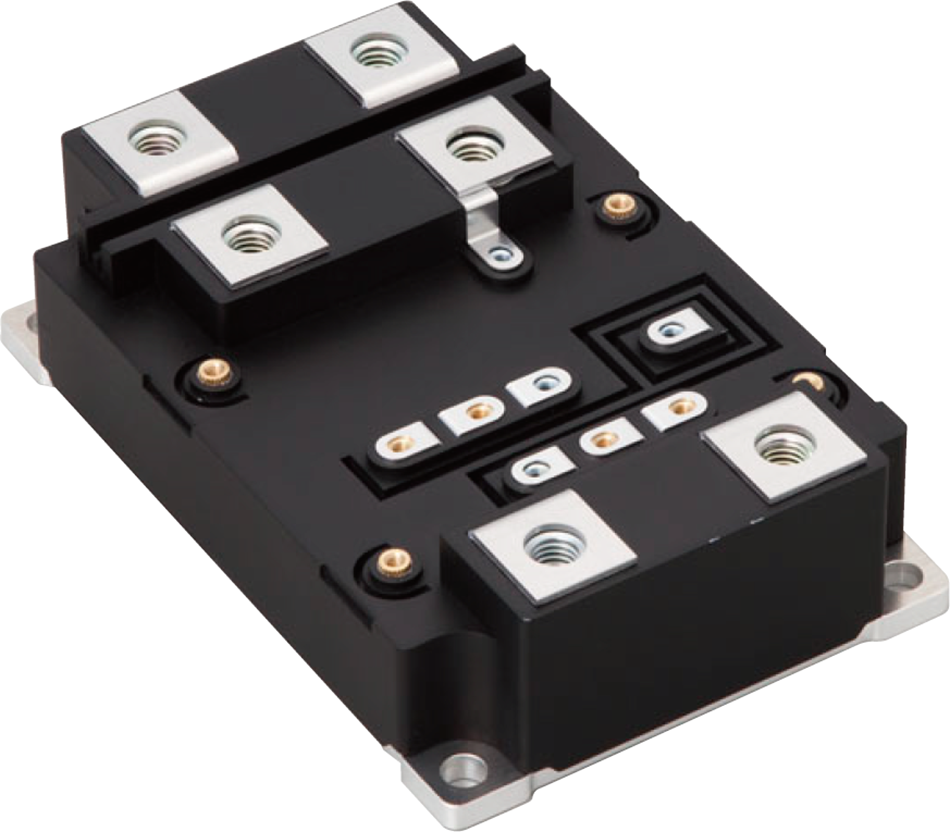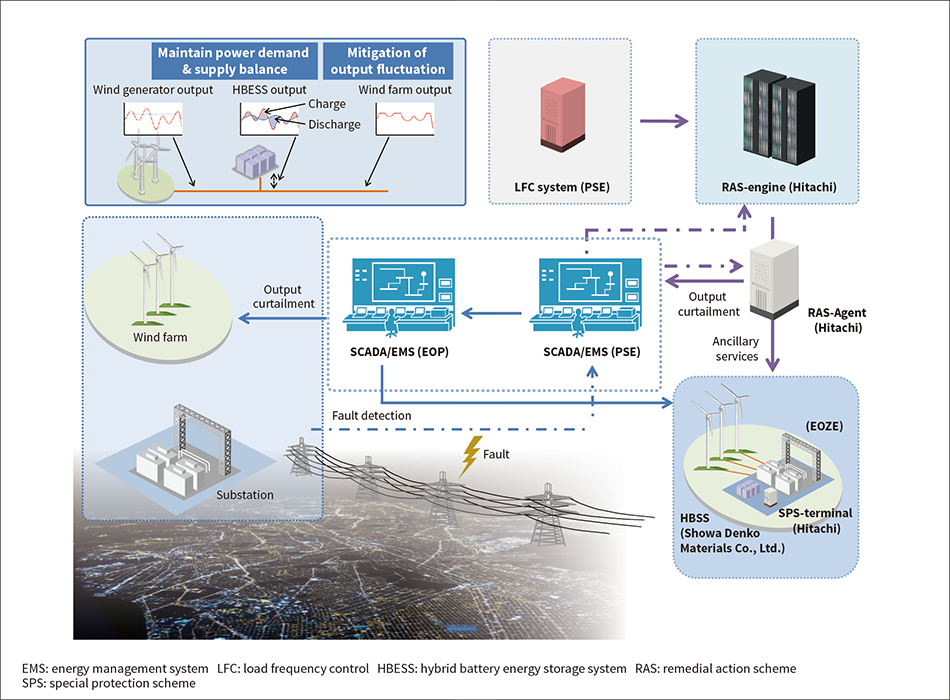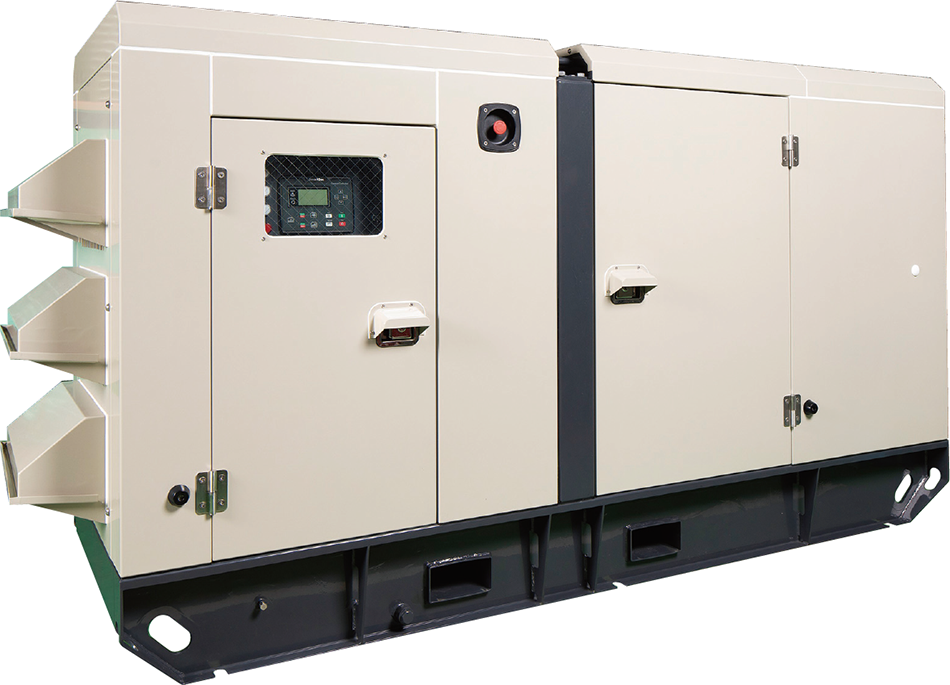EnergyEnergy
1. Transmission Line Protector Using Ethernet Communication from Chubu Electric Power
The rapid advancement of the information-oriented society in recent years has resulted in increasingly advanced communications network technology. For example, general-purpose communications technologies that enable high-speed, high-capacity communications such as Ethernet communications and the Internet Protocol (IP) are becoming increasingly commonplace.
Pulse code modulation (PCM) current differential relays are protective relay devices for transmission lines. They transmit current data back and forth between terminals and calculate the differential current to detect whether a failure has occurred in the applicable line interval. These devices were developed about 30 years ago, and have always used power company communications equipment for data transmission.
The plesiochronous digital hierarchy (PDH) communications method has conventionally been used along with a dedicated communications control board mounted on the protective relay device. Hitachi has recently developed a transmission line protective relay device that uses a layer 2 (L2) switch (a general-purpose Ethernet communications device), making it possible to use a general-purpose Ethernet interface instead of a dedicated communications board. By replacing dedicated communications equipment with general-purpose Ethernet, the developed device enables a greater degree of freedom in transmission line configurations and helps lower overall protection relay system cost.
Grid connection of renewable energy-based power sources is expected to grow in the coming years. However, when connected within line intervals protected by transmission line protective relays, these power sources could generate outflow currents causing unneeded operation of transmission line protective relays when external failures occur. So, a new function for preventing unneeded operation has been provided.
The device was developed as a resistance-grounded transmission line protective relay device. Its configuration uses separate lines and supports up to eight terminals. Hitachi started making successive shipments to power stations starting in July 2020, and the first unit began operating in September 2020.
2. Veuxbus Series Digital Relays: A Single-unit Solution
Hitachi’s Veuxbus series is a major product line provided mainly to Japanese power companies. Veuxbus series models are protective devices used to protect components such as substation busbars, substation transformers, and transmission lines. The analog relays in widespread use among general power providers have been used for over 30 years and are ready for upgrading. Meanwhile, upgrading with previous Veuxbus series models has led to over-engineering that creates problems in terms of installation space and cost.
Hitachi has responded by looking into ways of consolidating functions to meet the needs of general power providers. The company has released a new Veuxbus series that has a compact, single-unit configuration and a correspondingly low price range. While the models of the previous series were each composed of multiple units, the new series models have been given a more compact, single-unit configuration through a number of design innovations. For example, the analog input, digital input/output (I/O), and other I/O circuits have been pared down to just the items needed by general power providers. Transmission circuits used for differential current protection have also been integrated into the central processing unit (CPU) board. Since these refinements have reduced cost and made prices competitive, Hitachi will be proposing these single-unit models to general power providers seeking to upgrade their analog relays.
3. Release of Digital Relays (RB Series) for Nuclear Power
Discontinued analog relay models are still commonplace among the power panels used at nuclear power plants in Japan. Upgrades to digital models are essential as these old relays approach their maintenance deadlines. The digital replacements need to support retrofitting and provide reliability at least as high as the analog models they replace.
Hitachi has solved these issues by developing the REGRE-B (RB) series of single-element digital relays that have mounting dimensions compatible with previous models and improved reliability made possible by redundant internal relay circuits. Standard single-element digital relays are composed of a single internal circuit, and are expected to have a higher malfunction rate than their analog counterparts. RB series models are expected to provide a lower malfunction rate than analog relays by providing redundant operation circuits and control power supplies, along with a configuration featuring two trip output circuits and a bypass. To enable these redundant circuits to be mounted in a case of the same size as previous models, RB series models have carefully refined the placement of parts used and the circuit configuration to reduce size and support retrofitting.
4. Delivery of 1,100 kV Gas-insulated Transmission Line (GIL) to State Grid Corporation of China for Sutong UHV-GIL Project
To meet the rapid growth of electric power demand in China, the State Grid Corporation of China (SGCC) has been expanding its 1,100 kV (ultra-high voltage, UHV) transmission network since the pilot grid began commercial operation in 2009. An initiative known as the Sutong GIL project, 1,100kV GIL connects the UHV grids north and south of the Yangtze River, and the construction work was completed and SGCC began power transmission in September 2019.
The Sutong project was the first UHV-class project of GIL transmission in the world. SDEE Hitachi High-Voltage Switchgear Co., Ltd. (SDEE Hitachi), Hitachi’s switchgear manufacturing base in China, was selected as one of the GIL suppliers in this project. The GIL was co-developed by the power grid division of Swiss multinational ABB Group (now Hitachi ABB Power Grids Ltd.) and US infrastructure provider AZZ Inc. One of two gas-insulated transmission lines was delivered by SDEE Hitachi after a type test and long-term reliability verification tests. The GIL is 5.7-km in length and installed in a tunnel connecting Suzhou on the south bank and Nantong on the north bank of the Yangtze River. The three phases of GIL shown on the right side in the photo are produced by SDEE Hitachi, and the rated current is 8,000 A. The start of operation of this GIL project has enabled large-capacity power transmission across the Yangtze River and the GIL is contributing to a stable power supply to Shanghai and the rest of the Yangtze Delta region.
5. Embedded HVDC to Provide Cleaner and More Reliable Power
To integrate the increased development of renewable generation, there is a need for new power transfer corridors. Schemes based on high voltage direct current (HVDC) technology with subsea and underground cables, instead of alternating current (AC) overhead lines, can offer network reinforcement quickly and reduce planning timescales.
In addition to the substantial transmission capacity, an HVDC voltage source converter link provides valuable AC system support, through the reactive power capability, voltage control, black-start, and island mode operation. The Caithness-Moray HVDC link in Scotland shows these benefits and are now extended to a multi-terminal HVDC system, connecting Shetlands wind power to mainland while also increasing the Shetland grid reliability.
The Caithness-Moray HVDC link has been designed as a five terminal HVDC system. The design studies used the virtual control system (VMACH), with the actual control software, which enabled verification of the performance already in the design phase, ensuring fast and efficient tests and commissioning of the system, and in the end, reliable power to the end consumer.
(Hitachi ABB Power Grids Ltd.)
6. Pioneering Eco-efficient High-voltage Switchgear Technology
Hitachi ABB Power Grids Ltd. supports the reduction of greenhouse gas emissions in the electrical power industry to build reliable and greener grids. The company has been deploying sulfur hexafluoride (SF6) alternatives for high-voltage technology since 2010 that can reduce almost 100% of the global warming potential compared to SF6.
The first SF6 alternative live tank breaker 72.5 kV with using carbon dioxide/oxygen mixture (CO2/O2) was introduced in 2014 and has more than 100 installations around the globe. Hitachi ABB Power Grids installed the world’s first*1 170-kV high-voltage eco-efficient gas-insulated switchgear (GIS) with SF6 alternative gas (C5-FK mixture) in Switzerland and the world’s first*1 live tank breaker 145 kV using CO2/O2.
The company supports the smooth transition to SF6-free high voltage equipment and is delivering the first 420 kV SF6- alternative GIS to transmission operator in Germany, TransnetBW GmbH for the Obermooweiler substation in two steps*2:
- All passive components with SF6 alternatives, significantly reducing SF6, to be commissioned in 2021.
- All components with SF6 alternatives including switching elements to be commissioned in 2026.
(Hitachi ABB Power Grids Ltd.)
- *1
- Based on Hitachi ABB Power Grids’ research
- *2
- The company handled specification, project planning and design of the world’s first 420 kV SF6-free GIS.
7. Capability and Flexibility of Energy Storage Enhanced STATCOMs in Low Inertia Power Grids
The inertia of synchronous generators is a source of short-term energy storage in the form of rotational kinetic energy, which is critical to safeguarding the frequency of power grids. Due to the high penetration of renewables, a lower number of synchronous generators are being connected to power grids. To compensate, services such as synthetic inertia and fast frequency response services are being introduced.
These services can be addressed using energy storage-enhanced static synchronous compensators (E-STATCOMs), a new solution based on power electronics. In comparison to synchronous generators, an E-STATCOM’s synthetic inertia response is not dependent on its physical design. Comparing a 250 MVA synchronous generator to a 250 MVA E-STATCOM, the E-STATCOM’s response is comparable to a synchronous generator 20 times larger. For future power grids dominated by renewable generation, E-STATCOMs will prove a flexible and effective means to safeguard the power grid.
(Hitachi ABB Power Grids Ltd.)
[7] Comparison of synchronous generator (synch. gen.) and E-STATCOM providing synthetic inertia
8. Pilot Experience of Real-time Communication between Digital Substations
Hitachi ABB Power Grids will deliver a first-of-its-kind “substation to substation” digital solution to Abu Dhabi Transmission and Despatch Company (TRANSCO), Abu Dhabi, U.A.E, as part of the 400 kV Al Dhafra switching station project. The project introduces a complete range of technologies and innovative concepts and a range of products and solutions necessary to achieve a complete end-to-end (E2E) digital substation solution.
It introduces new and innovative fully digital control, protection and communication features for mission-critical applications and is part of wider innovation enabling the digital transformation of the power industry.
It achieves the digitalized E2E protection concept and also introduces a unique application that is the first of its kind to be delivered in the region. This solution allows TRANSCO to guarantee performance and correct operation of the application, compare the availability of service and at the same time, provide substation network separation.
(Hitachi ABB Power Grids Ltd.)
9. DERs: Impact of Reverse Power-flow on Transformer
Wind and solar account for most of the new renewable generating capacity globally. The highly unpredictable nature of these energy sources and insufficient energy storage at the generating nodes of distributed energy resources (DERs) leads to reverse power-flow towards the grid. Today’s challenge is that the levels of increased voltage and voltage harmonics caused by reverse power-flow have been mostly not communicated or not considered in transformer specifications.
With the transformer operating at nominal design it observes higher excitation voltage and significantly higher core losses at various power factor conditions of reverse power-flow. This impacts the life of interconnected transformers, with the extent of impact depending on design and operating conditions with reverse power flow conditions causing loss of transformer life by up to 25%.
The life of a transformer can be maintained as per International Electrotechnical Commission (IEC) guidelines by restricting the power factor close to unity. Or to operate transformers without loss of life under unrestricted power factor conditions, customized transformers can be developed based on the system analysis and study.
(Hitachi ABB Power Grids Ltd.)
[9] Bi-directional power-flow due to the renewable integrations in modern transmission and distribution grids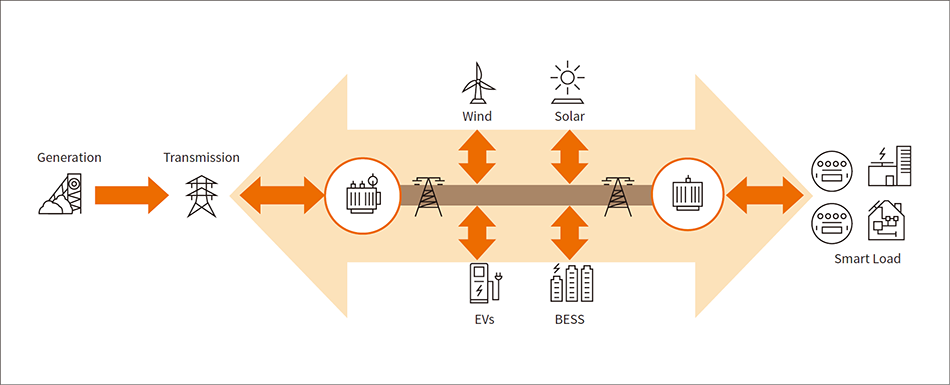
10. Battery Energy Storage for Frequency and Power Profile Regulation
Major industrial energy demand on the island of Grand Bahama can create dramatic changes in load which significantly impact system frequency. In response, the local utility, Grand Bahama Power Company, has been operating with a high unit commitment to increase system inertia for regulation reserve in an attempt to maintain the 60 Hz grid frequency.
A 9.5 MW/7.31 MWh battery energy storage system (BESS) was designed and installed to provide synthetic inertia to the grid to mitigate frequency swings resulting from load fluctuations from these industrial loads. The BESS was designed to achieve more efficient operation of the reciprocating engine generators and run less online spinning reserve, resulting in operating cost savings, while also improving frequency regulation.
During the commissioning of the BESS project, Grand Bahama was hit by Hurricane Dorian causing significant damage to infrastructure. The BESS remained online, and aided in the recovery of the electrical grid in the days and weeks following the storm. The preliminary results in this paper show that the BESS is operating as intended and having positive impacts on grid frequency regulation on Grand Bahama.
(Hitachi ABB Power Grids Ltd.)
11. Energy Storage System Addresses Challenges of Grids with High Penetration of Renewables
The Australian National Electricity Market (NEM) has experienced dramatic transformation due to rapid uptake of both small-scale and large-scale renewable energy generation, and the closure of multiple coal power plants. The Australian state of South Australia epitomizes this transformation as the share of renewable energy generation in the state grew from 14% in 2009 to 51% in 2018, dominated by wind power, with instantaneous wind penetration reaching over 140% in relation to demand. This high presence of non-synchronous generation reduces system strength that has traditionally been provided by synchronous plants.
Both technological and commercial insights were gained from the Dalrymple energy storage for commercial renewable integration (ESCRI) BESS, as the first grid forming BESS installed on the NEM to address challenges introduced by high shares of renewable generation in South Australia. The BESS is built on the virtual synchronous generator technology, which strengthens the grid by replicating the behavior and performance of a synchronous machine, providing virtual inertia, high fault current injection, seamless islanding and other services.
(Hitachi ABB Power Grids Ltd.)
12. Microgrid Control Provides Efficient, Reliable Management of Distributed Resources and Energy Storage Systems
The Aiken commercial and industrial grid-connected microgrid project is located in South Carolina, USA and includes a combination of DER such as solar photovoltaics (PV), BESS, and a diesel engine, as well as industrial and office loads.
A key objective of this microgrid project is to provide a practical demonstration of how microgrids can achieve energy resiliency, peak shaving, cost savings, integration of renewables, and non-wires alternative (NWA).
The major challenges for this microgrid project are at the nexus of regulatory policies with evolving grid codes, and protection requirements. The additional DER in the microgrid will exceed the hosting capacity of the substation. Hence, either substation upgrades or NWA are required. The microgrid shows how the integration of different distributed energy resources such as PV, BESS, and diesel can be integrated together with an intelligent control system to provide an energy solution that effectively reduces carbon emissions, reduces costs and improves energy resiliency.
(Hitachi ABB Power Grids Ltd.)
13. Enhancing Transmission Capacity to Support Integration of Renewable Energy
In coming decades, most carbon-free energy in the USA will come from large-scale wind, solar, and hydro generation. Most of the best sites for renewable energy generation in the country are located in sparsely populated areas, or offshore, far from existing power transmission routes and consumer centers.
To facilitate integration of renewables into the grid, significant investment in the nation’s transmission infrastructure is needed. A critical first step is to improve interconnection capacity between remote areas favorable for renewable energy and major load centers. HVDC technology, a cost-efficient and sustainable means of transmitting large amounts of electricity over long distances, with low losses, offers an attractive option. Regional transmission systems, based on AC, can also benefit from modernization using technologies such as flexible alternating current transmission systems (FACTS), which can increase power transfer capabilities, stability, and control of AC systems. These and other associated technologies can lay the groundwork for wide-spread adoption of renewable generation throughout the country, offering long-term economic, social, and health benefits.
(Hitachi ABB Power Grids Ltd.)
14. Multi-Terminal UHVDC System: Delivering Sustainable Energy to 90 Million People
India’s northeast has abundant hydropower resources, but load centers are hundreds and thousands of kilometers away. Hitachi ABB Power Grids’ pioneering multi-terminal HVDC technology has enabled transmission of 6,000 MW of power over 1,775 km to Agra, the city of Taj Mahal.
The North-East Agra project has several technology firsts: world’s first and longest* 800 kV multi-terminal HVDC transmission project, first to have 12-pulse converter terminals, managing challenging right-of-way situation, highest converter capacity at 8,000 MW and having 800 kV indoor DC halls. The project has been designed with a continuous 33 percent overload feature, the first of its kind in the world*. The earth electrode has been designed for 5,000 amperes direct current continuous current.
And, the system to operate in the bipolar, monopolar (ground return/metallic return) and hybrid modes of operation, providing wide flexibility in the case of outages in different HVDC line sections and/or different converters. The technology helps in minimizing losses, cost of transmission, maintaining a stable national grid, making it stronger, smarter and greener.
(Hitachi ABB Power Grids Ltd.)
- *
- As of October 2020, based on research by Hitachi ABB Power Grids Ltd.
15. Automatic Changeover to Prevent Grid Blackouts
In its 2018 Smart Grid System Report, the US Department of Energy outlined several issues facing the grid including variability and intermittency of renewable generation, changing load patterns and unpredictability, the need to manage a vast number of end points, and the growing cyber-attack risks to the grid, among others. Availability of reliable power remains critical. As the distribution network develops towards an intelligent network, distribution system operators (DSOs) will need more and more smart monitoring and control devices to handle all different tasks.
Hitachi ABB Power Grids offers an automatic transfer System (ATS) for its remote terminal units (RTUs), designed to implement an automatic changeover from the main power source to alternative energy in secondary distribution networks. Recognizing an upstream failure on the active source, the solution will change from main to reserve supply in three seconds. The ATS is based on intelligent grid analysis, which protects connected assets, especially those sensitive to under-frequency. The ATS is flexible enough for retrofitting regardless of switchgear, and offers maximum flexibility and availability to meet requirements of today and tomorrow.
(Hitachi ABB Power Grids Ltd.)
16. Quantum-Safe Encryption Helps Secure Omanʼs Power Network
Oman Electricity Transmission Co. (OETC) owns and operates the main power network transmitting electricity from generating stations to distribution load centers across the Sultanate of Oman. To digitalize operations and support a growing number of bandwidth intensive services, OETC looked to migrate their communication network. Security was a key requirement for the upgrade, as new packet-switched technology could make the communication network more vulnerable to threats.
Hitachi ABB Power Grids’ FOX615 quantum-safe network solution enabled OETC to meet all their requirements in a single product, by minimizing operational complexity, while eliminating migration risk and service disruption. Through modular design, the device can scale to support multiple services, each with its own set of specific requirements, over a shared packet infrastructure with guaranteed performance.
This new communication system for OETC is among the first in the world* to feature a quantum-safe security card with E2E encryption for mission-critical utility networks. The quantum-safe security solution uses physical properties of light to generate truly random encryption keys, guaranteeing security with real-time performance.
(Hitachi ABB Power Grids Ltd.)
- *
- Based on research by Hitachi ABB Power Grids Ltd.
17. Knowing When Assets Will Fail: The Crucial Role of Prognostics in Utility Asset Management
Equipment failure. It’s on the minds of utility equipment operators everywhere. It’s disruptive, expensive and unpredictable. But it doesn’t have to be that way. One of the many improvements brought on by digital transformation are new possibilities in asset lifecycle management that minimize total cost of ownership or support intelligent maintenance strategies.
New tools promise to shift asset management from a traditional time-based approach to a much more cost-efficient, condition-based approach. However, risk and maintenance decisions still rely heavily on subjective expert judgement combined with prescriptive and inflexible maintenance plans and rarely incorporate data analytics on asset future condition. Without a reliable and proven method for anticipating equipment performance, operators are hard pressed to change their ways. What the experts need from their asset management tool is prognostic information to support decisions, rather than having to solely focus on the technical performance of the equipment. New asset performance management (APM) technology today offers the insights needed to determine future outcomes.
(Hitachi ABB Power Grids Ltd.)
18. Five “Intelligences” at the Heart of the Digital Utility
The digital revolution is underway everywhere. It is reshaping how people communicate, how people connect, and what people expect from data. It is simultaneously disruptive and instructive – bringing a quick end to outdated practices and upending rigid structures while ushering in the digital industrial era where innovative technologies turn data into game-changing insights. For a utility to become a digital utility, it must change its perspective to overcome the challenges created by data proliferation and harness the benefits of five “intelligences.” These intelligences include:
- A holistic perspective: An all-encompassing view of the organization
- Situational intelligence: Understanding and responding to events
- Timely intelligence: Fast, accurate transmission and interpretation of information
- Actionable intelligence: Information presented in a way that facilitates better decision making and decisive action
- Evolving intelligence: Continuous improvement of situational, timely, and actionable intelligence capabilities to provide progressively sophisticated view of the enterprise
(Hitachi ABB Power Grids Ltd.)
19. Digitalization and the Future of Asset Performance Management
Fortune tellers in ancient China used heated metal pokers to create cracks in bones. They used the patterns in the cracks to predict the future, and recommended actions that affected the fate and fortunes of states. We now laugh at these primitive, superstitious methods of prediction, but we should recognize that even in their primitive form, fortune telling practices had an important benefit for early civilizations: namely, organizing people around a common course of action in the face of uncertainty.
In this age of big data, we should not forget that collaboration and alignment are still vitally important outcomes of our predictions. Modern analytics have raised the bar on predictive precision, but they have not removed risk and uncertainty from our decision making. APM solutions often focus on the technical details of data collection, processing, and presentation. While important considerations, APM solutions in the era of big data should not be primarily a big data analytics solution. Instead, they should be strategic tool for efficient collaboration.
(Hitachi ABB Power Grids Ltd.)
20. Digital Transformation of the Distribution Grid
Modern utilities are increasingly adopting decentralized models that allow power to flow to the grid from many points or nodes, mainly from renewable energy sources such as wind and solar, BESSs and microgrids. These models require the grid to be capable of accommodating multi-directional, unpredictable electricity flows, which adds to the complexity of grid management.
New digital technologies allow data from sensors at substations, smart metering systems and other connected devices to be collected and delivered to the control room via wired and wireless broadband communication networks. The data can then be processed by software applications powered by artificial intelligence (AI) that provide operators with detailed views of their grid and enables fast, accurate decision making.
The application of digital productivity tools and automation of processes translate into immediate and substantial improvements of the bottom line of the utility company. Utilities that adopt an agile, thoughtfully designed digital approach are poised to deliver an improved customer experience, enabling them to thrive in this transformative age of digital energy.
(Hitachi ABB Power Grids Ltd.)
21. A Transforming Grid Connecting Islands with HVDC
With growing integration of renewables, further interconnection between AC-grids can increase grid reliability by enabling power trading with power resources. HVDC can transport power with maximum efficiency and minimal losses.
Around the globe countries have embarked on this grid transition journey. The Japanese Higashi-Shimizu project will reinforce the connection between the 50 Hz network in Eastern Japan and the 60 Hz network in Western Japan. The connection is expected to significantly strengthen and help develop electricity transfer and increase power reliability. The interconnection capacity of the Higashi-Shimizu substation will increase from 300 MW to 900 MW and increase power reliability for the end user.
Similar applications are seen in Europe with Kriegers Flak interconnecting the Danish and German grid while also integrating wind power, and the newly announced Shetland link that will interconnect Shetland to UK mainland, integrating large scale wind power.
(Hitachi ABB Power Grids Ltd.)
22. HVDC Meets the Challenges of Integrating Renewables
Renewable energy plays a major role in moving towards a carbon-neutral energy system. This will require changes in how power is transmitted and distributed in the future, to have the dynamic, flexible and stable grid. The grid needs to be updated to the needs of today and tomorrow, where generation often will be located far from consumption areas.
HVDC, the world’s first* technology developed by Hitachi ABB Power Grids, offers the flexibility, controllability and resilience needed for large scale integration of renewables. The low losses also make it suitable for massive bulk transmission, enabling trade of renewable resources between countries and regions.
A growing market for HVDC is the integration of offshore wind. The next step will be to combine interconnections and offshore wind connections with building up connecting networks such as the UK to the Continental system, opening for multiterminal HVDC installations or even DC grids. HVDC also has a vital role to play where system capacity needs to be built up within a country, with transmission corridors like in Germany.
(Hitachi ABB Power Grids Ltd.)
- *
- Based on research by Hitachi ABB Power Grids Ltd.
[22] HVDC applications offer integration of renewables, interconnection of asynchronous grids between countries and regions and large scale power transmission with minimal losses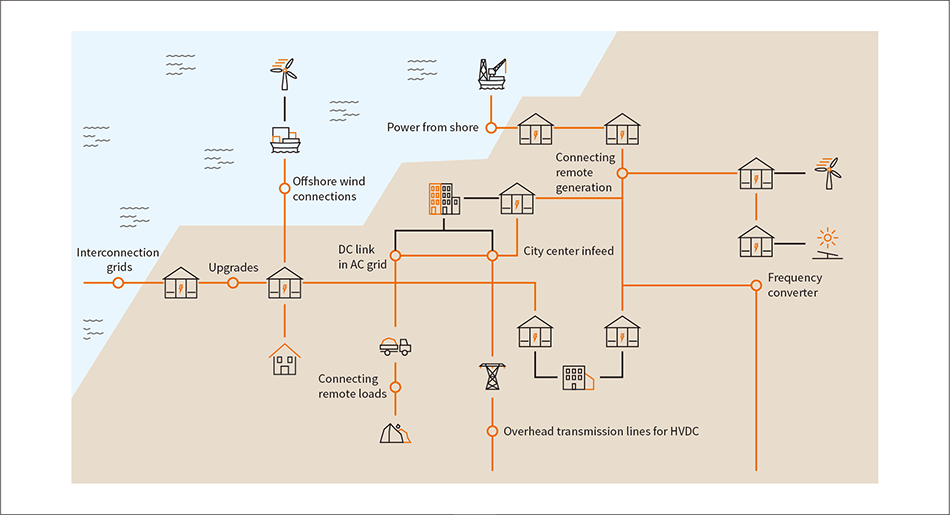
23. Modular Mobile Substation for Rapid Disaster Recovery
Hitachi ABB Power Grids has pioneered a ground-breaking modular mobile substation solution that greatly reduces the time needed to restore power after major disruptive events like natural disasters, ensuring long-term stability and power quality.
It is mainly comprised of hybrid switchgear, power transformer, and control room modules installed with a high degree of functional integration. The modules are deployed on a trailer with independent suspension and rear steering axles for easy transportability, on-site manageability and fast removal, minimizing environmental impact.
The modular mobile substation covers multiple voltage levels (up to 420 kV) and power (up to 500 MVA), comes pre-assembled and factory pre-tested to reduce installation and energization time from an average of 18 months to only seven days, compared to a traditional substation.
This robust mobile energy solution provides a reduced footprint optimizing space usage, needs little to no civil works to set up, can tolerate all weather conditions and harsh environments from -40°C to +40°C – a perfect solution for grid disaster recovery.
(Hitachi ABB Power Grids Ltd.)
24. Optimized High-Voltage Switchgear to Support Renewables
The growing demand for renewable energy is pushing the offshore wind industry towards an increase in the unit power of wind turbines, with the latest models reaching up to 10–12 MW. This is leading to a switch from 33 kV to 66 kV in the offshore network, though minimizing the losses and reducing the levelized cost of energy (LCoE).
Committed to sustainable development, Hitachi ABB Power Grids has developed a compact and robust switchgear based on its hybrid switchgear plug and switch system (PASS) – PASS M00 for 66 kV wind towers. The internal fault protection all around the switchgear ensures best-in-class safety standards for the operators. Its excellent resistance to vibration, humidity and corrosion has been tested in the most severe conditions. Thanks to its modular design, it can adapt to any type of wind towers in terms of footprint and accessibility, offering a wide range of customized single-line diagrams.
(Hitachi ABB Power Grids Ltd.)
25. Addressing Challenges in Offshore Wind via DC Gas-Insulated Switchgear Technology
Offshore wind power in the North Sea has become a key source of large-scale renewable energy and provides a significant share of clean electricity in Europe. To explore the benefits and challenges of inter-connecting wind farms in a meshed-transmission grid, the European Union (EU) has established a project called “Progress on Meshed HVDC Offshore Transmission Networks” (PROMOTioN).
To help address the challenges of meshed-grid offshore wind transmission in the North Sea, Hitachi ABB Power Grids has developed and installed the first-of-its-kind* HVDC GIS at the EU project test site.
The prototype installation test of a 320/350 kV HVDC GIS was successfully completed in July 2020. Throughout one-and-half years of continuous testing, the HVDC GIS technology successfully demonstrated its technical maturity and operational readiness for real-world application. HVDC GIS reduces the overall footprint of the installation and the total cost for the offshore platform. The HVDC GIS 320/350 kV as a technology milestone, enables the future development of cost-effective HVDC transmission lines.
(Hitachi ABB Power Grids Ltd.)
- *
- Based on research by Hitachi ABB Power Grids Ltd.
26. Digital Generator Circuit-breaker for Pumped Storage Power Plants Supporting Renewable Integration
With the increase in renewable power generation, pumped storage power plants (PSPP) contribute significantly towards maintaining grid stability. Generator circuit-breakers (GCBs) are used in PSPP for protection of plant assets from severe damage and reducing the possibility of costly downtime. In a normal operation, GCBs are used to switch between generating and pumping modes frequently. As such, GCBs need not only be extremely reliable, but to operate flawlessly. However, the continuous operation of the GCBs increases the erosion of the contact material, thus reducing its efficiency over a period of time.
Therefore, it is important to accurately measure the erosion of contacts to maximize the usage of the GCB. Hitachi ABB Power Grids’ breakthrough monitoring solution for GCBs, GMS600-GTA, provides precise measurement of the erosion that enables a predictive maintenance strategy. The usage of GMS600-GTA in conjunction with the controlled switching device, PWC600 for the interruption of current, provides distinct technical and economic benefits, such as the reduction of total cost of ownership by approximately 60% and efficient operations of PSPPs to enable a stronger grid.
(Hitachi ABB Power Grids Ltd.)
[26] Evolution of the total cost of ownership over the lifetime of 20 years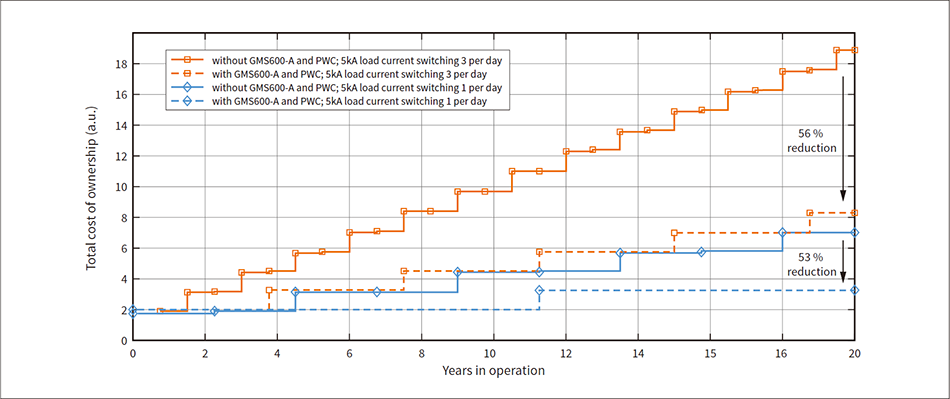
27. Deploying Battery Energy Storage System in Smart Fossil-Free Island
Hitachi ABB Power Grids has teamed up with Groupe Renault to give electric vehicle (EV) batteries a new lease of life and support the integration of clean energy into the grid, as part of the “Sustainable Porto Sant” initiative launched by the Portuguese Government for this small island on the South-Western edge of Europe.
While a fundamental part of this initiative is to increase the production of renewable energy on the Porto Santo Island, the challenge is the intermittent nature of solar and wind energy.
The solution for this comes from integrating second life EV batteries from Groupe Renault with Hitachi ABB Power Grids’ battery energy storage solution. This setup provides the capability to store excess energy generated by the island’s renewable sources. This way, the power stored in the batteries can be fed back into the network during periods of high electricity demand, with smart precision.
This energy storage solution will be part of the intelligent electrical ecosystem of Porto Santo and will ensure the complete utilization of the island’s wind and solar generation potential.
(Hitachi ABB Power Grids Ltd.)
28. TXpert Ecosystem for Digitalization of Transformers
The ongoing digital acceleration of the world’s electrical systems is improving their safety, productivity, accessibility and sustainability. In this context, Hitachi ABB Power Grids launched the TXpert ecosystem, a complete platform of products, software, services and solutions to make digitalization of transformers simple.
TXpert is an open, scalable and manufacturer agnostic ecosystem. With a universal scope, it can provide data-driven intelligence for any transformer, regardless of its origin and application.
The TXpert hub is the heart of the TXpert enabled transformers and provides data monitoring, diagnostics and connectivity, either locally or cloud based, with stringent cybersecurity standards.
The ecosystem includes APM solutions for individual or multiple transformers and remote and advanced services to ease smart decision making for transformer operation and maintenance.
TXpert provides data driven intelligence based on the knowledge of manufacturing and servicing thousands of transformers – delivering insights to reduce costs and risks, optimize operations, extend life-expectancy and enhance environmental performance, enabling millions of dollars in savings through greater flexibility, efficiency and resilience.
(Hitachi ABB Power Grids Ltd.)
29. WindSTAR Power Transformers for Powerful Wind Turbines
WindSTAR transformers, specifically designed for floating wind turbines, are installed in the three 8.4 MW MHI Vestas Offshore Wind A/S (MVOW) wind turbines on the WindFloat Atlantic, floating offshore wind farm. These are the world’s largest* and most powerful wind turbines ever installed on a floating foundation. They are 190 m tall and can provide enough electricity for over 18,000 households.
The WindFloat Atlantic windfarm, operational since 2019, is positioned 20 km off the coast of Viana de Castelo, Portugal, in a location where the sea is 100 m deep. Traditional offshore wind turbines are secured onto the seabed and can only be used in depths of approximately 40–50 m.
WindSTAR transformers are specifically engineered to be compact and extra resilient against extreme and sudden movements encountered on floating wind farms. These 66 kV transformers will facilitate offshore wind farms installed in deeper waters where fixed-foundation turbines are not feasible. This 66 kV voltage level is the highest wind turbine rating in the industry, allowing for significant reduction in transfer losses and enabling higher efficiency.
(Hitachi ABB Power Grids Ltd.)
- *
- As of October 2020, based on research by Hitachi ABB Power Grids Ltd.
30. Pacific Intertie HVDC Link
For 50 years, the 1,360-km Pacific Intertie HVDC Link has been transmitting hydroelectric power from the Pacific Northwest to as many as three million households in the greater Los Angeles area. This HVDC transmission system was the first major HVDC link in the USA*, achieving the vision of the late US president, John F. Kennedy.
In 1970, the link had a capacity of 1,440 MW with minimized transmission losses by utilizing high-voltage and direct-current electricity. Since then, Hitachi ABB Power Grids has upgraded this system several times, increasing the power capacity to 3,800 MW. Yet its latest innovations – especially in transformer design – enabled this increase in power within the same footprint as the original 1970 converter stations.
This was achieved by building the world’s most powerful and compact convertor transformers by using an innovative three-winding design, enabling the upgrade with half the number of conventional transformers. The increased power per core-limb, in combination with staying within the transportation limitations was the key to make this possible.
(Hitachi ABB Power Grids Ltd.)
- *
- Based on research by Hitachi ABB Power Grids Ltd.
31. Transformers with Transient Voltage Protection for Efficient Data Centers
The switching of a site’s electrical network can be one of the most nerve-wrecking experience for data center network managers. Depending on network characteristics, switching of medium-voltage (MV) breakers can produce over-voltages throughout electrical systems that can lead to equipment damage and potential failure.
Traditional protective solutions, such as resistor-capacitor (RC) snubber circuits, require expensive system studies and add unwanted complexity to electrical networks. Hitachi ABB Power Grids’ transient voltage protection (TVP) technology for distribution transformers, however, eliminates this extra complexity as well as any threats of switching failures.
By using integrated winding varistors, the TVP technology limits over-voltages not only for the transformer but all downstream equipment. It is maintenance free and works in any MV network without complex design. The TVP technology for distribution transformers; the perfect solution for risk-free network switching.
(Hitachi ABB Power Grids Ltd.)
32. Phoenix: The Worldʼs First Hybrid Synchronous Condenser System
The changing generation landscape in the UK power network has created challenges related to inertia, short circuit levels, and voltage control. FACTS devices play an increasingly important role as part of the suite of technology solutions that are chosen to address changing power system needs. STATCOMs, static var compensators (SVCs) and other dynamic reactive power compensation systems have seen increasing adoption rates globally, while synchronous condenser systems (SCSs) have experienced a sort of “renaissance” due to the increasing need for inertia and short circuit reinforcement.
This article introduces Phoenix, an innovative project that aims to overcome these challenges by bringing together SCS and STATCOM technologies to form the world’s first* hybrid synchronous condenser (H-SC) system. The combination of these complementary technologies is feasible and beneficial in modern power systems and is being developed and demonstrated in the Phoenix project – a Network Innovation Competition (NIC) funded project led by Scottish Power Energy Networks Holdings Limited (SP Energy Networks).
(Hitachi ABB Power Grids Ltd.)
- *
- Based on research by Hitachi ABB Power Grids Ltd.
33. Digitalization Enabling Remote Transformer Service
Electrical grid networks cover wide geographic areas. Substations, which may include transformers, are critical elements of the grid, and can be located in very remote places. Operators can avoid unnecessary visits to sites, and optimize maintenance spend by adopting condition-based maintenance. In addition, the impact of COVID-19 has brough about a growing demand for digital remote services and changed the way Hitachi ABB Power Grids supports customers on sites.
To meet this market demand, the company’s transformer service business developed monitoring services supporting customers to secure performance of their transformers. Sensing and monitoring devices within the TXpert ecosystem enable transformer operational data to be gathered and analyzed within the company’s APM diagnostic software to quantify transformer condition and provide priorities for maintenance.
Remote consulting services using diagnostic information can be combined with augmented reality tools to support hands on field service testing and fault finding. Hitachi ABB Power Grids’ portfolio of digital remote services enables global experts to link with local service teams to bring the company’s best knowledge and capability avoiding unplanned downtime for customers.
(Hitachi ABB Power Grids Ltd.)
[33] Remote monitoring using mobile CoreSenseTM M10 (left) and diagnostic APM dashboard showing real time transformer condition (right)
34. Supporting the Vision to Create a Sustainable Mine of the Future
Hitachi ABB Power Grids is collaborating with Swedish mining and mineral group Luossavaara-Kiirunavaara AB (publ) (LKAB) to help develop and launch the next generation of sustainable mining production at LKAB’s iron ore mines in northern Sweden. One of LKAB’s biggest future challenges is the need to develop and install a new mining system that is digitalized, autonomous and carbon-dioxide-free at deeper and deeper levels underground, as mineral resources are depleted at current main level depths.
LKAB plans to increase mine production by almost 50%, and needs a more accessible, efficient and flexible power system that is secure, uses sustainable energy sources and enables reduced energy consumption. System studies have been done by LKAB and Hitachi ABB Power Grids’ experts. Hundreds of digital models of power systems involving multiple scenarios have been developed and tested to support the design and configuration of the future mine’s energy system. LKAB gets much-needed decision support and tailor-made solutions early in the process, based on these results and conclusions.
(Hitachi ABB Power Grids Ltd.)
35. New Digital Service Solution: RelCare
Hitachi ABB Power Grids’ RelCare is a maintenance partnership solution that helps customers increase the reliability, sustainability and financial performance of critical substation assets. The company’s experts utilize state-of-the-art asset management software combined with service partnership models to optimize the performance, yield and protection of crucial systems across their lifecycles.
Leveraging a shared, user-friendly digital platform, RelCare enables rapid, transparent and data-driven decision-making about asset reliability in real-time, and efficient remote evaluation of maintenance works. Reducing the need for on-site visits, RelCare solutions also help to increase site safety and operator productivity in substation assets of all kinds, from transmission and distribution installations to connection substations for renewable plants, datacenters, industries, and smart mobility charging stations.
RelCare provides targeted maintenance based on dynamic system reliability and financial modeling; increased maintenance quality thanks to an advanced maintenance management system and operational return of experience; standardized maintenance execution based on harmonized safe work method statements (SWMS); and real-time monitoring of substation system key performance indicators.
(Hitachi ABB Power Grids Ltd.)
36. Low-loss SiC Hybrid Module with 1.7 kV Side-gate HiGT
Hitachi Power Semiconductor Device, Ltd. has developed a 1.7-kV/1,000-A low-loss silicon carbide (SiC) hybrid power module that uses a next-generation compact 2-in-1 package for power converters used in rolling stock and other applications. The SiC hybrid power module is configured by combining a SiC Schottky barrier diode with a silicon insulated-gate bipolar transistor (Si-IGBT). SiC Schottky barrier diodes have a much greater ability to reduce reverse recovery currents than Si diodes.
A side-gate high-conductivity IGBT (HiGT) structure with reduced gate capacitance is applied to an Si-IGBT to further boost the module’s loss reduction, while a compact package with an internal inductance reduced to 10 nH reduces switching loss by 50% relative to Hitachi Power Semiconductor Device’s previous SiC hybrid module products. The module is mounted on power converters to let them support higher switching frequencies, helping enable more compact and lightweight passive components such as converter system reactors.
(Hitachi Power Semiconductor Device, Ltd.)
37. 35-A/12-V Super low-loss diode for Alternators
Hitachi Power Semiconductor Device has developed a super low-loss diode (SLLD) for use in the alternators (generators) of gasoline and diesel engine vehicles. The new diode reduces the voltage drop during rectification to just one-fifth the level of previous products.
It is composed of a metal-oxide-semiconductor field-effect transistor (MOSFET) for rectification, a Zener diode (ZD) for surge protection, a controller integrated circuit (IC) for ON-OFF control, and a capacitor to supply power to the controller IC. Despite using these four components, the new SLLD still manages to achieve the same external product shape as previous diodes through the use of three-dimensional mounting technology. This unchanged external shape provides a major benefit to customers who can continue to use existing equipment during alternator assembly.
Using the new SLLD also creates major environmental protection benefits by improving alternator power generation efficiency about 6% and reducing CO2 by 1.2 g/km*.
(Hitachi Power Semiconductor Device, Ltd.)
38. Smart Grid Demonstration System for Expanding Use of Renewable Energy in Poland
Hitachi has completed the delivery of a smart grid demonstration system designed to expand the use of renewable energy in Poland, where the system has begun operation. The system was delivered to Polskie Sieci Elektroenergetyczne S.A. (PSE; Poland’s national power transmission company), Energa-Operator S.A. (EOP; a power distribution company in northwestern Poland), and Energa OZE S.A. (EOZE; a power generation company in northwestern Poland).
The main features of the system are as follows:
- Using online information from the power grid to continuously perform calculations, this system proposes response measures by simulating the grid conditions that would result in the event of a grid fault. When an actual grid fault occurs, this system prevents transmission-line overload by using the results of prior simulations to automatically control wind power generators and other controlled equipment.
- A hybrid power storage system that combines high-output lithium-ion batteries and high-capacity lead storage batteries is used together with a grid stabilization system to provide reserve capacity and enable use for eliminating transmission-line overloading.
This project was commissioned by the New Energy and Industrial Technology Development Organization (NEDO).
39. Power Supply Solutions Using Emergency Power Generation Equipment
Ensuring the availability of reliable power supplies for maintaining lifelines is an issue to consider when creating business continuity plans (BCPs) and disaster readiness plans in preparation for the typhoons, earthquakes, and other natural disasters that occur frequently in recent years. Installing emergency power generation equipment is an effective way to solve this issue. Hitachi Power Solutions Co., Ltd. has a lineup of products tailored to various customer needs. It provides integrated systems that cover everything from equipment planning to model selection and maintenance services after installation.
The company also handles periodic inspections, proposes inspection plans, and offers other maintenance and management proxy services for customers. It provides a comprehensive range of maintenance services that reduce the customer’s management workload. To ensure that normally dormant emergency power generation equipment will operate reliably during a power failure, equipment operation states are monitored periodically by remote operation. Sampled data and inspection records are also analyzed to diagnose failure and malfunction precursors to assist with preventive maintenance and keep equipment in prime condition. When problems are detected, service engineers are quickly sent out from service centers throughout Japan to deal with the problem and help ensure that power will be available in the event of a power failure.
(Hitachi Power Solutions Co., Ltd.)
40. Development of the DioVISTA/Dam System for Assisting Reservoir Operation
Frequent heavy rains caused by climate change are forcing reservoir operators to find completely new operation methods to prevent flood damage. Intuition and experience are not helpful for finding optimum solutions during operations such as pre-discharging to lower the reservoir water level before a typhoon, or coordinating multiple reservoirs.
Hitachi has developed a technology to assist reservoir operation, and is working on releasing it as the DioVISTA/Dam system for reservoir managers. The system combines simulations and AI to predict reservoir inflow volumes, and uses Progressive Dynamic Programming (a numerical optimization method) to automatically draw up discharge plans for pre-discharging or discharging during a flood.
The DioVISTA/Dam screens display information needed for deciding on discharge plans. They show items such as future reservoir inflow volumes, reservoir operation plans, reservoir conditions, downstream water levels, and flood conditions. Reservoir operation plan can also be drawn up for each of the objectives and its priority. The screens shown here are for a reservoir operation plan drawn up when the objective is to minimize downstream river flow without sudden fluctuations in the water level downstream. DioVISTA/Dam is scheduled to release in FY2021.
(Hitachi Power Solutions Co., Ltd.)
[40] Screens displayed by the DioVISTA/Dam system for assisting reservoir operation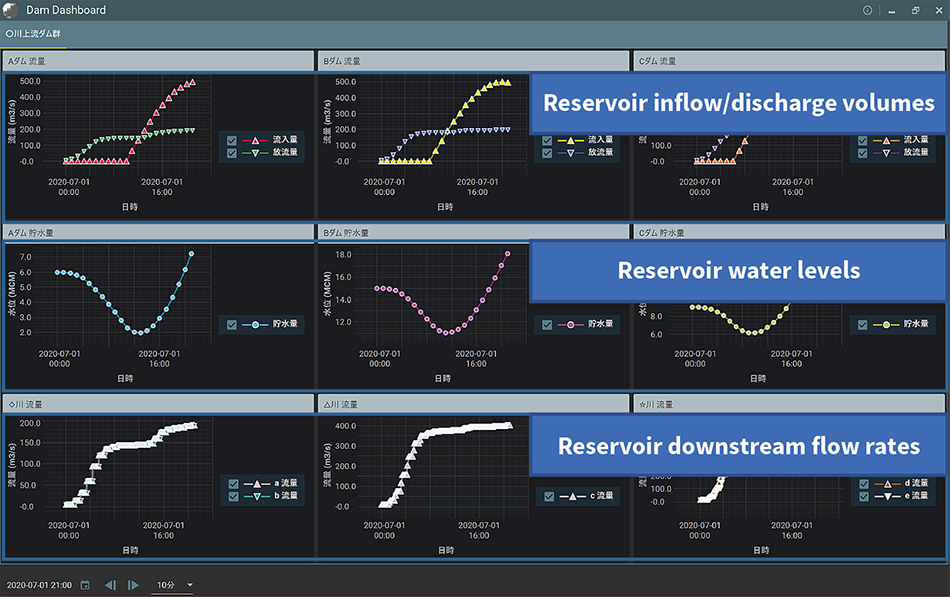
41. Real-time Noise Monitoring System
A growing risk of failures caused by aging parts has recently been causing problems for equipment maintenance work by creating down time and increasing maintenance costs. Monitoring using sound data is an area of growing demand since it provides a non-contact sensing method for identifying failure precursors. Sound also plays a role in environmental assessments. Businesses do not only need to manage their noise levels to meet the regulatory standards at site boundaries, but they also need to take careful steps to prevent noise from reaching nearby residences.
Hitachi Power Solutions has responded to these needs by providing a real-time noise monitoring system that measures the noise produced by equipment running in factories or power plants. The noise is continuously measured at multiple locations, and the noise levels and frequency trends to be assessed are visualized. Machine learning is also applied to the gathered data to quantify equipment abnormality levels and automatically differentiate between noise produced by normal and abnormal equipment. This feature helps equipment owners detect problems early and carefully devise environmental response measures.
(Hitachi Power Solutions Co., Ltd.)
[41] Equipment configuration of real-time noise monitoring system